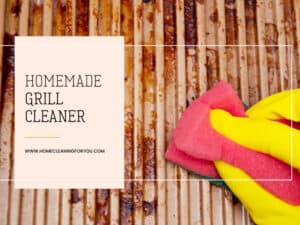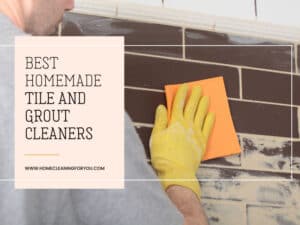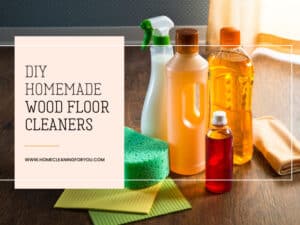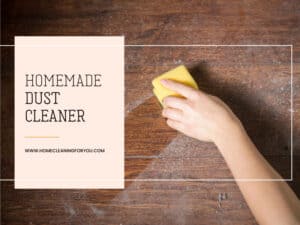11+ Best Homemade Stainless Steel Cleaners That Sparkle

Homemade stainless steel cleaners are toxic-free and cost-effective, making them seem more attractive than store-bought options in the long term, especially for people who like to collect stainless steel things.
Let’s count how many stainless steel appliances and items you have in your home. I’m sure the number is much more than you think.
This material is not only long-lasting, corrosion-resistant, germ-resistant but also easy on the eye. In addition, you can always add more coordinating stainless steel items to decorate your house.
With many such items, it’s pretty challenging to take care of them and keep them shiny all the time. Luckily, some straightforward homemade cleaning tips and tricks do wonders to these appliances.
Keep scrolling to find out!
Reliable Homemade Stainless Steel Cleaners You Must Know
Stainless steel items are highly susceptible to dirt and fingerprints during daily use. Therefore, periodical cleaning is essential to maintain their shine.
This is when homemade stainless steel cleaners are needed, thanks to their efficient cleaning effects and inexpensive ingredients. Let’s discover some incredible methods below:
Lemon Essential Oil
Not only does it smell soothing, but the lemon essential oil is also great at eliminating unpleasant odor and disinfecting surfaces. This ingredient is a natural and safe way to clean around your house. Also, it’s an integral part of a homemade stainless steel cleaner which I mention below.

What You’ll Need
- Lemon essential oil
- Water
- White distilled vinegar
- Dishwashing liquid
- A microfiber
- Spray bottle
Step 1: Prepare The Cleaning Mixture
Let’s first fill a spray bottle with 1 ½ cup of white distilled vinegar and 1 ½ cup of water, then add 6 drops of dishwashing liquid and 24 drops of lemon essential oil. Give it a good shake.
Step 2: Apply The Solution
Spray the solution on your stainless steel items and wipe them gently with a microfiber cloth.
Do you know how to make lemon essential oil at home? I’ll show you now!
Vinegar And Olive Oil
Vinegar can clean and disinfect your items, while olive oil is known for getting rid of grimes, smudges and restoring shine.
You can use any oil in your house, for example, coconut oil, if you run out of olive oil. The best part? Oil also prevents fingerprints from appearing again for a while.

What You’ll Need
- Water
- Vinegar
- Olive oil (Other oil products of your choice)
- A spray bottle
- A dry cloth
Step 1: Create A Mixture
Add 1 part of water and 1 part of vinegar into a spray bottle.
Step 2: Wipe The Appliances
Spray a generous amount of this solution directly onto the items you want to clean. Take a closer look at your appliances and keep the soft cloth going with the grain direction. You can wipe either horizontally or vertically.
Step 3: Rub With Olive Oil
After cleaning it with a vinegar solution, wait a few minutes until the surface is completely dry, squirt some olive oil on the cloth, and rub gently all over the appliance according to the grain direction.
Olive oil can help your stainless steel products shine again.
Rubbing Alcohol
Rubbing alcohol is versatile due to its disinfecting, cleansing, and polishing qualities. Keep it handy because you might use it more frequently than you imagine; for example, you can make a DIY cleaning solution for screens from it.It’s straightforward to find in any grocery store on a health product shelf or drug store.
In addition, cornstarch can help you clean your stainless steel utensils and appliances without streaks and helps to restore a like-new, sparkle look.
Option 1: Rubbing Alcohol And Essential Oil
Wanting shiny stainless steel items with a wonderful smell? This method is what you need.
What You’ll Need
- Rubbing alcohol or vodka
- Cornstarch
- White vinegar
- Lemon essential oil
- Orange essential oil
- Distilled water
- A spray bottle
Step 1: Create A Mixture
Pour ¼ cup of rubbing alcohol or vodka with ¼ cup of vinegar in a spray bottle using a funnel.
Step 2: Add Cornstarch And Essential Oils
Continue to add 1 tablespoon of cornstarch, 5 drops of lemon essential oil, and 5 drops of orange essential oil to the bottle.
Step 3: Add Distilled Water
Add 2 cups of distilled water into the spray bottle. Shake well to mix all the ingredients.
Step 4: Apply The Mixture
Spray directly onto stainless steel appliances and wipe down the surface with a microfiber cloth.
Stainless steel surface and more can be cleaned easily with rubbing alcohol. Let’s find out!
Option 2: Rubbing Alcohol And Distilled White Vinegar
This potent yet straightforward mixture can easily clean the stainless steel around your house. Try it now.
What You’ll Need
- Rubbing alcohol
- Distilled white vinegar
- Water
Step 1: Create A Mixture
Blend 12 ounces of water, ½ cup of rubbing alcohol, and ⅓ cup of distilled white vinegar in a spray bottle.
Step 2: Spray And Wipe
Spray a fair amount of this solution on the stainless steel surface and wipe to clean.

Vinegar

It’s a safe bet that you have a jar of vinegar at home that can be used for both cooking and cleaning. I remember applying it on my shirt to quickly eliminate tide pod stains from the fabric.
Vinegar is also a powerful method when it comes to cleaning your stainless steel fixtures, appliances, and utensils, especially discolored pots and pans. Here’s a step-by-step instruction:
What You’ll Need
- Warm water
- White distilled vinegar
- 2 microfiber cloths
Step 1: Prepare The Mixture
Start by pouring 1 cup of white distilled vinegar and 1 cup of warm water in a bottle.
Step 2: Wipe The Household Items
Pour the cleaning solution on a microfiber cloth and wipe appliances following clockwise direction. Use another new cloth to wipe in a counterclockwise motion until the surface dries completely.
Tomato Sauce
Have you ever heard about this cleaning method? It appears so effective that I highly recommend that you give it a try whenever you have any tomato sauce leftover from the last meal.
Its acidity performs surprisingly well to remove rainbow-colored discoloration marks and white calcium buildups on kitchenware, especially pots and pans.
What You’ll Need
- Water (Optional)
- Tomato sauce
- A microfiber cloth
Step 1: Apply Tomato Sauce On The Affected Area
Fill the pot or pan with a lot of tomato sauce to soak the dirty mark thoroughly.
Step 2: Simmer The Sauce
Turn on the heat and keep the sauce simmer for about 10 minutes. Feel free to add water if you want. Skip this simmering step and let the sauce stay overnight if you have time.
Step 3: Rinse As Usual
Wipe off the sauce with a microfiber cloth and rinse with water as you usually do.

Club Soda
You might all know that club soda is carbonated water often used as an essential ingredient for many thirst-quenching drinking formulas.
The dissolved gas in club soda works as a temporary surfactant (1), which surprisingly turns into an efficient household stain removal remedy. It’s said that club soda can make an excellent treatment for food stains on fabric. I agree and guarantee that you will see the result in a flash.
Below are simple instructions for a shiny stainless steel fridge, stovetop, or more:
What You’ll Need
- Club soda
- A microfiber cloth
Step 1: Apply The Club Soda
Spray club soda all over the appliances. Don’t miss any corners so that you don’t have to reapply.
Step 2: Wipe The Surface
Wipe your items carefully with a clean microfiber cloth to remove any dirt and food particles on them.

Hydrogen Peroxide
If you’re in love with homemade cleaning remedies, you might be familiar with the powerful combination of hydrogen peroxide and cream of tartar. It can eradicate even stubborn and pesky rust stains from garments. Now, try it on your stainless steel appliances and see how it works:
What You’ll Need
- Hydrogen peroxide
- Cream of tartar
- Water
- 2 clean cloths
Step 1: Assemble The Solution
Create a paste of 1 teaspoon of hydrogen peroxide and 3 teaspoons of cream of tartar.
Step 2: Rub It On The Dirty Things
Apply this paste all over your appliances, utensils, and fixtures. Make sure that you don’t leave any area untouched.
Step 3: Wipe Off The Paste
Allow the paste to dry, then wipe the paste with a damp, clean cloth. Wipe again with a clean, dry cloth until the entire surface is dry.

Baking Soda And Lemon Juice
Lemon juice contains a high concentrate of citric acid (2), which removes limescale buildups and enhances the cleaning power of soap and laundry detergents. It’s also known as the quickest method to get rid of coffee marks on garments.
In addition, vinegar is excellent for combating water streaks, while baking soda can easily scrub away old stains on stainless steel. That is to say, it’s a safe bet that this method works amazingly for you and your appliances.
What You’ll Need
- White distilled vinegar
- Baking soda
- Water
- Lemon juice
- Clean cloths
- A dry towel
Step 1: Wipe Your Items With Vinegar
Dampen a clean cloth with white distilled vinegar and wipe it all over the surface of your appliances.
Step 2: Prepare A Cleansing Paste
Mix 1 quart of water and 4 tablespoons of baking soda to form a paste and rub it onto the stainless steel items using a soft cloth. Let the paste stay for several minutes, then remove it with a dry towel.
Step 3: Rub With Lemon Juice
Dampen another cloth with lemon juice and rub it to the item to eliminate limescale sticking to the stainless steel surface.
Step 4: Rinse With Water
Flush with a lot of water and wipe with a clean towel until they dry.

Vinegar, Dishwashing Liquid, Baking Soda, And Olive Oil
This is a winning combination of various ingredients you can easily find in your house. Let’s follow my instructions below to achieve the ultimate result right away!

What You’ll Need
- White distilled vinegar or cider vinegar
- Warm water
- Dishwashing liquid
- Baking soda
- Olive oil
- A spray bottle
- Clean rags
Step 1: Prepare A Mixture
Mix ½ cup of white distilled vinegar or cider vinegar and ½ cup of warm water in a spray bottle. Next, add 2 tablespoons of baking soda and 2 tablespoons of dishwashing liquid. Mix well.
Step 2: Apply The Cleaning Solution
Spray a fair amount of the cleaning solution on the stainless steel items and wipe with a clean rag.
Step 3: Apply Olive Oil
Pour olive oil on another clean rag and rub it evenly on the utensil or appliances you’ve just cleaned. Buff dry with one more clean rag.
Olive Oil, White Vinegar, Lemon Essential Oil
Wanting a clean and shiny fridge in a blink? This method is right here for you. Let’s give it a try.
What You’ll Need
- White vinegar
- Olive oil
- Lemon essential oil
- A spray bottle
Step 1: Get The Mixture Ready
Pour half a cup of white vinegar, half a cup of olive oil, and 20 drops of lemon essential oil into a spray bottle. Move the bottle up and down to combine all the ingredients.
Step 2: Spray And Wipe
Spray all over the stainless steel items with the cleaning solution and wipe according to the grain of the surface with a microfiber cloth.

How To Clean Stainless Steel Pan And Cookware
Have you ever experienced burnt pan accidents when cooking? Burnt foods? Or discoloration cookware? These methods will give you a helping hand.
Get Rid Of Burn Marks
Burn marks seem to stay permanently on your stainless steel cookware. However, if you know how to deal with them, you can still remove these nasty stains effortlessly.
Baking Soda And Dish Soap
Combine baking soda and dishwashing liquid to form a paste, then apply this cleaning paste all over the burn marks. Allow it to work for a few hours before rinsing your pans and pots with a lot of water and drying on the kitchen rack.

Baking Soda
Apply baking soda on the burn marks at the bottom of your pans and pots. Make sure your cookware is completely dry. Rub the stain with a dry cloth to scrape it off. Add a bit of water if you want. When the burn marks fade, rinse and dry with a cloth.

Boiling Salt/Lemon Juice/Vinegar
This straightforward cleaning option is perfect for the inside of your pan instead of the bottom.
Fill the pan or pot with enough water to submerge the impacted spot, bring to a boil, and add several tablespoons of salt/lemon/vinegar. Let the mixture sit for several hours. Pour all the solution out of the pan and scrape inside with a soft sponge.

Soda
Cleaning burnt oil from stainless steel pans can be much easier with this familiar drink. Let’s give it a try.
Pour cola into the pan to cover the oily spots. Heat until it boils. After that, turn off the heat and scrub off burnt oil.

Lift Burnt Food
Leaving your foods too long on the heat can lead to burnt crud sticking to the inside of the pan. Below are some ways to tackle this type of stain.
Dishwashing Liquid
For tough burnt food, use a non-abrasive scrubber to remove as much food sticking to the stainless steel cookware as possible.
Fill the pot with a soapy solution made from dishwashing liquid and water so that the burnt foods are soaked entirely. Bring the water to simmer, then use a spoon to remove stuck-on food.

Vinegar and Baking Soda
Fill the pot or pan with a good amount of water, 1 cup of vinegar, and bring it to a boil. The cleaning solution should be high enough to cover burnt foods.
Then, turn off the heat, add 2 tablespoons of baking soda and stir well. Empty the pot and scrub well to remove all clingy food foods.

Cream of Tartar
Again, create a paste of water and cream of tartar and smear it on the stained area. Let the mixture stay overnight before rinsing and scrubbing the food.

Salt and Lime
Add lime juice and salt into the pan or pot you need to clean and wait for a few minutes. Continue to add salt into the pan. Use a non-abrasive scrubber to scrub away the food. Rinse and pat dry.

Removing Discoloration
This method is super quick and straightforward, which you can easily follow just by rinsing your pan with vinegar, then rinsing again with water.
For white calcium buildups on your pots and pans, you can fill the need-to-treat pans and pots with 3 parts of water and 1 part of vinegar, then bring it to a boil. Let the cleaning solution cool and wash as usual.
Here are instructions for cleaning your cookware. Let’s explore more.
Make Exterior Stainless Steel Grill Look New
After a BBQ party, you might feel disheartened when looking at the grill. However, there’s an easy way to tackle it. Let’s see.

Lemon, Lime, Or Orange
Pick one of the above fruits and start cleaning by making a paste of its juice and salt. Rub it onto the stainless steel grates and allow it to stay for 10 minutes, rinse with warm water and quickly dry them with a towel.
For fingerprints and grime, rub lemon slices directly to the affected area.
Vinegar And Olive Oil
Spray white vinegar on the grill and wipe it gently to clean all the grimes and stuck-on foods. After this, add a few drops of olive oil on a clean cloth and pat it on the stainless steel.
Baking Soda
Daub a paste of water and 3 tablespoons of baking soda on the grill grates using a sponge. Make sure you don’t leave any area untouched. Rub gently and flush them with water to remove the baking soda.
Water And A Cloth
Warm water and a lint-free cloth can work wonders for stainless steel grates. Just keep in mind that you should pat them dry to prevent water streaks.
Valuable Tips When Cleaning Stainless Steel Surfaces
Stainless steel is a long-lasting material; however, it stays new only if you know how to take care of it correctly. Below are some common mistakes you should keep in mind to maintain the original condition of your stainless steel appliances.
- It would be best to never use scouring pads, steel wool, and scrubbers with abrasive materials to sanitize stainless steel appliances because they can cause severe damage to the surface. To be more specific, they will leave unsightly marks and scratches.
- For a shiny surface, you can wipe your equipment daily with a soft cloth, microfiber cloth, or even an old T-shirt. A paper towel is not advisable.
- If you don’t want to clean every day, oil can be applied to create a coating that prevents lime buildup, grimes, and fingerprints.
- Hard water contains many minerals that can stay on the surface of stainless steel items and make unwanted mineral deposits.
- Chlorine-based products, abrasive cleaners, and oven cleaners are also not good in this case.
- It’s highly recommended that you wipe according to the grain direction on the appliance’s surface.
- For stainless steel sink and faucet, you can clean with a vinegar solution or rub it with slices of lemon. Moreover, don’t spray vinegar on the unsealed grout because vinegar can affect its longevity.
- Before cleaning, remember to unplug small appliances and allow them to cool. For larger equipment, you don’t need to unplug but clean when your heating items have been turned off and cooled down.
- Cover the sink with a fair amount of flour, and soon it will shine right in front of your eyes.
FAQs
Don’t hesitate to ask the questions on your mind about homemade stainless steel cleaners. I’m here to help you answer each of them.
Always Keep Your Appliances Shine
Things in your house tell others about you more than your words; therefore, keeping everything clean and tidy, in this case, maintaining the spark of all your stainless steel appliances, is an essential task.
I believe everyone can achieve this goal as easily as pie with all provided methods. The best part? Most of the ingredients I’ve suggested above can be used for various household purposes, so they are worth stocking in your house.
How about you? Do you have anything else valuable to add to the list? Feel free to drop me a line in the comment section so I can reach you as soon as possible.
I look forward to hearing from you.








Samantha Lee
Head Cleaning Expert
Expertise
Professional Home Cleaning, Green Cleaning Techniques, Stain Removal & Fabric Care, DIY Home Maintenance & Organization, Sustainable Cleaning Products, Home Care for Busy Lifestyles
Education
University of Denver
Samantha Lee is the Head Cleaning Expert at HomeCleaningForYou.com, specializing in eco-friendly home care. She holds a Bachelor of Science in Environmental Science from the University of Denver, focusing on sustainable cleaning solutions.
With expertise in green cleaning, stain removal, and DIY home maintenance, she helps homeowners keep their spaces fresh and chemical-free. Samantha has been featured in lifestyle publications and has partnered with brands promoting natural cleaning products.
She also shares practical tips through her blog, online courses, and workshops. Passionate about sustainability, she enjoys testing new eco-friendly cleaning methods and spending time outdoors.